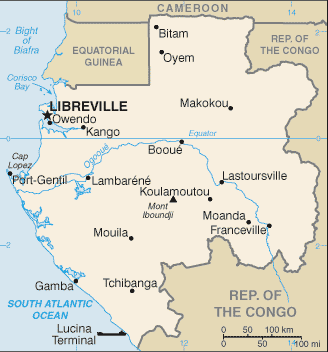Nuclear Reactors 604 - Ancient Natural Nuclear Reactors In Gabon
Gabon-map.gif

I like to say that nuclear power is the most complex, expensive and dangerous way to boil water ever invented by the human race. To think that natural processes could have created a crude nuclear reactor might seem like saying that natural processes could create a car but apparently there were natural nuclear reactors many years ago.
Gabon (officially the Gabonese Republic) is a small country on the west coast of Africa, south of the Ivory Coast. It was once a French colony. Oklo is a region near the Gabonese town of Franceville in the Uaut-Ogooue province of Gabon. In 1956, French prospectors found uranium in Oklo. France immediately began mining uranium there, but the mines were exhausted before the year 2000.
In 1956, Paul Kazou Kuroda, a Japanese-American chemist and nuclear scientist, predicted that it might be possible for certain natural environmental conditions to give rise to nuclear fission reactions. In 1972, Frances Perrin, a French physicist, found geochemical evidence of natural nuclear fission in circumstances in Oklo very close to those predicted by Kuroda. The evidence for natural fission processes including the balance of some isotopes including neodymium, ruthenium and uranium. Evidence for such reactions were eventually found at sixteen sites in Oklo. Oklo is the only place in the world where such natural nuclear fission reactions have been found.
The natural fission processes occurred because uranium-rich ore deposits were flooded by groundwater which acted as a neutron moderator. Nuclear chain reactions were the result. The fission process generated heat which caused the ground water to boil away, slowing or halting the reaction. After the ore deposit cooled and the water returned, the reaction started again. This cycle took about three hours. The reactions went on for hundreds of thousands of years. This all happened about two billion years ago.
Now a team from the U.S. Naval Research Laboratory and Washington University is studying the natural fission reactions at Oklo and they have published a paper in the Proceedings of the National Academy of Sciences. They took core samples in Oklo in a quest for information on exactly how nuclear fission byproducts decay over time. The samples were examined with the Naval Ultra Trace Isotope Laboratory’s Universal Spectrometer.
One of the main things the researchers were working on was the fate of cesium that was produced by the fission process. The researchers found that an element called ruthenium absorbed the cesium only five years after the end of the fission reaction. It has been held there for the last two billion years.
The discovery of cesium absorption by ruthenium has inspired speculation that there may be lessons to be learned for the disposal of nuclear waste generated by commercial nuclear power reactors. Ruthenium itself is too expensive to be used for this purpose but there may be an element or compound similar to ruthenium that could be used. Any new techniques that can be developed to assist in the disposal of nuclear waste would be very useful considering that we have many tons of waste to dispose of.